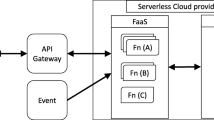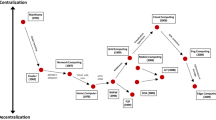Abstract
In mobile transparent computing, a large number of concurrent data requests from heterogeneous clients via the network need to be processed in a timely fashion, and servers have to repeatedly fetch (search and read) the data from storage, which may cause numerous I/O costs. Generally, disk access speed is more limited than memory; therefore, massive I/O operations at servers may become a bottleneck for the system, and transport delay of the total network caused by the limitation of wireless bandwidth and stability may lead to poorer user experience. Hence, caching method plays a significant role in performance improvement of transparent computing systems. In this paper, we propose a block-level caching optimization method for the server and client by analyzing the system bottleneck in mobile transparent computing. We first analyze the storage format of the data file and the three-layer structure in the server according to the characteristics of requesting data from the client to the server and propose a block-level cache based on the access time and access frequency for the server. Second, considering the restriction of bandwidth and stability of the wireless network, we analyze network boot processes from the client’s startup and propose a client block-level cache optimization combined with local storage access technology. Finally, experimental results demonstrate that the server block-level cache optimization can effectively reduce the amount of server disk I/O, improving the concurrent ability of the server. In addition, the client block-level cache can significantly increase startup speed of the client, reduce network traffic and improve user experience.









Similar content being viewed by others
References
Zhang Y (2004) Transparence computing: concept, architecture and example. Acta Electronica Sinica
Zhang Y (2008) The challenges and opportunities in transparent computing 2008 IEEE/IFIP international conference on embedded and ubiquitous computing, vol 1. IEEE Computer Society, p 3
Zhou Y (2012) Transparent computing: from concept to implementation International symposium on information technology in medicine and education, vol 1. IEEE, pp 5–5
Wei L, Zhang Y, Zhou Y (2007) TransCom: a virtual disk based self-management system International conference on autonomic and trusted computing, vol 4610. Springer, pp 509–518
Zhou Y, Zhang Y, Xie Y, Zhang H, Yang L, Min G (2014) Transcom: a virtual disk-based cloud computing platform for heterogeneous services. IEEE Trans Netw Serv Manag 11(1):46–59
Zhang Y, Zhou Y (2012) Transos: a transparent computing-based operating system for the cloud. Int J Cloud Comput 1(4):287–301
Wu M (2012) Analysis and a case study of transparent computing implementation with uefi. Int J Cloud Comput (4):312–328
Zhang Y, Zhou Y (2013) Transparent computing: a spatio-temporal extension on vonneumann architecture for cloud services. Tsinghua Sci Technol 18(1):10–21
Zhang Y, Zhou Y (2007) 4vp: a novel meta os approach for streaming programs in ubiquitous computing. pp 394–403
Kuang W, Zhang Y, Zhou Y, Guangbin XU, Wei L, Gao Y (2009) Nsapa network storage access protocol for transparent computing. Journal of Tsinghua University
Zhang Y (2006) Transparent computing: a new paradigm for pervasive computing. Ubiquitous intelligence and computing. Springer, Berlin Heidelberg
Zhou Y, Zhang Y (2010) Transparent computing: concepts, architecture, and implementation
Xu G, Zhang Y, Zhou Y, Wei L, Chen C (2008) Design and implementation of a virtual machine-based transparent computing system. J Tsinghua Univ 48(10):1679–1678
Gao Y, Zhang Y, Zhou Y (2012) Performance analysis of virtual disk system for transparent computing International conference on ubiquitous intelligence & computing and, international conference on autonomic & trusted computing. IEEE, pp 470–477
Liang W, Xiong y, Wu M (2013) A cross platform computing method and its application for mobile device in transparent computing
Xia N, Zhang Y, Yang S, Wang X (2006) Design of i/o server based on transparent calculation model. Comput Eng 32(21): 61–63
Gao Y, Zhang Y, Zhou Y (2013) A cache management strategy for transparent computing storage system. Commun Comput Inf Sci 320:651–658
Li W, Zhang Y, Zhou Y (2009) Simulation analysis and validation of cache performance in transcom systems. J Tsinghua Univ 49(10):1700–1703
Liu J, Zhou Y, Zhang D (2016) Transim: a simulation framework for cache-enabled transparent computing systems. IEEE Trans Comput 3171–3183
Tan C, Yang L, Wen J, Li K (2011) Transparent computing system based on hierarchical cache. Comput Eng 37(5):270–272
He Y, Shen F, Zhang J, Jiang N, Li Q, Li J (2015) Cache optimization approaches of emerging non-volatile memory architecture: a survey. Journal of Computer Research & Development
Arteaga D, Zhao M (2014) Client-side flash caching for cloud systems International conference on systems and storage. ACM, pp 1–11
Nikolaou S, Van Renesse R, Schiper N (2015) Proactive cache placement on cooperative client caches for online social networks and applications. IEEE Trans Parallel Distrib Syst 27(4):1–1
Ren Y, Shen Z, Zhang J (2016) Research of block-level network disk cache technology in cloud computing system. J Chin Comput Syst 37(3):499–504
Xu Y (2015) Optimization of transparent computing system based on virtualization, Master’s thesis, Central South University
Bramson M (1994) Instability of fifo queueing networks with quick service times. Ann Appl Probab 4(3):414–431
Sokolinsky LB (2004) LFU-K: an effective buffer management replacement algorithm International Conference on Database Systems for Advances Applications, DASFAA 2004, Jeju Island, Korea, March 17-19, 2004, Proceedings. vol 2973, pp 670–681
Johnson T, Shasha D (1995) 2Q: a low overhead high performance buffer management replacement algorithm International conference on very large data bases, vol 4. Morgan Kaufmann Publishers Inc., pp 439–450
Zhou Y, Philbin J, Li K (2002) The multi-queue replacement algorithm for second level buffer caches General track: 2001 Usenix technical conference. USENIX Association, pp 91–104
Zhang Y, Guo K, Ren J, Zhou Y, Wang J, Chen J (2017) Transparent computing: a promising network computing paradigm. Comput Sci Eng 19(1):7–20
Guo K, Huang Y, Kuang L, Zhang Y (2017) CASP: a context-aware transparent active service provision architecture in a mobile internet environment. Comput Sci Eng 19(1):38–45
Acknowledgments
This work is supported by the Major Science and Technology Research Program for Strategic Emerging Industry of Hunan (2012GK4106), International Science and Technology Cooperation Special Projects of China (2013DFB10070), Hunan Science and Technology Plan (2012RS4054), Natural Science Foundation of China (61672535, 61472005, 61561027), Key Laboratory of Intelligent Perception and Systems for High-Dimensional Information of Ministry of Education Innovation Fund (JYB201502), Natural Science Foundation of Shanghai (16ZR1415100), Project of Innovation-driven Plan in Central South University (2015CXS010), Key Laboratory of Information Processing and Intelligent Control of Fujian Innovation Fund (MJUKF201735), and Graduate Student Research Innovation Project of Hunan Province (CX2016B049). The authors declare that they have no conflict of interests.
Author information
Authors and Affiliations
Corresponding author
Additional information
This article is part of the Topical Collection: Special Issue on Transparent Computing
Guest Editors: Jiannong Cao, Jingde Cheng, Jianhua Ma, and Ju Ren
Rights and permissions
About this article
Cite this article
Tang, Y., Guo, K. & Tian, B. A block-level caching optimization method for mobile transparent computing. Peer-to-Peer Netw. Appl. 11, 711–722 (2018). https://doi.org/10.1007/s12083-017-0554-8
Received:
Accepted:
Published:
Issue Date:
DOI: https://doi.org/10.1007/s12083-017-0554-8




